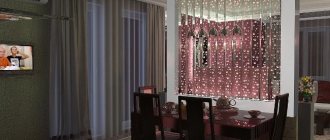People who like to spend time watching movies are increasingly interested in whether it is possible to assemble a home theater with their own hands.
Experts say this is quite possible. In order to get the most out of your cinema equipment, you need to take care of purchasing a multimedia projector/modern TV.
You will also need powerful speakers. Below you can familiarize yourself with the equipment that will be needed during the work process and advice from experts.
Connection diagram for home cinema at home
Do-it-yourself home cinema: why is it needed?
Not so long ago, having a home theater at home was considered an unaffordable luxury. However, today you can hardly surprise anyone by organizing a home theater in an ordinary apartment.
People are willing to pay to be able to enjoy watching their favorite movie on the big screen at any time, without leaving home. If funds are limited, you should try to assemble a home theater with your own hands. This will save the family budget and select equipment that can satisfy your wishes.
Note! The area of the room for arranging a home theater does not play a special role.
How to make yourself more comfortable?
Being comfortable is incredibly important, in my opinion. The classic solution is, of course, a sofa. To make it even more comfortable, you can throw pillows on it, and put banquettes or poufs for your feet.
A more atmospheric option for a cinema hall is chairs placed classically in a row.
You can sit directly on the floor on comfortable bean bags. Combine them with a sofa, in which case adults will fit on the sofa, and children will have more fun lying on soft poufs.
If you are lucky and manage to allocate a separate room for the cinema, you can make a multi-level structure from pallets for large family viewings.
Preparatory stage - what you should pay attention to before production
When starting to assemble a home theater, you should take care of proper distribution of space. To do this, draw a detailed diagram, allocating the necessary area for each component of the cinema, namely for:
- furniture (chairs and tables);
- audio systems (amplifier/speakers/subwoofer);
- video systems (projectors);
- ventilation (air conditioning);
- CD storage, minibar, etc.
Home theater placement in a studio room
Note! The optimal area for setting up a small home theater is considered to be a room in the range of 42-50 square meters. m.
What to consider when choosing a room, components of a future cinema and options for manufacturing
To make the movie viewing experience especially vivid, you should take care to darken the room in which the screen is installed. When choosing the dimming level, the luminous flux power of the equipment used should be taken into account. Most often, preference is given to projector models whose power is in the range of 400-2000 lm. In a room whose area reaches 40-50 sq.m, you can choose the following dimming levels:
- strong – brightness 200-500 ml;
- medium – brightness within 600-700 ml (the best option for watching a video in the evening when the lights are off);
- weak – brightness 900-1500 ml (ideal luminous flux for obtaining a clear image in dim daylight).
All windows in the room are covered with light filters or thick blinds. It is advisable to take care of installing adjustable lamps on the walls so that the eyes do not get tired of too saturated colors on the screen.
You will also need to ensure good sound insulation for your home theater. For this:
- the walls are covered with materials that absorb sound;
- the floor surface and wall surfaces are covered with carpet;
- the room is lined with fabrics with foil threads that absorb sound;
- the room is equipped with a sound-isolating door with a vestibule.
We should not forget about organizing proper ventilation and air conditioning of the room, because against the background of thermal radiation from the equipment, the temperature in the room often reaches uncomfortable levels.
When choosing a screen, the user can give preference to both the projector and the TV. Each option has advantages and disadvantages.
The main advantages of the TV include:
- image of good quality (sufficient level of brightness/contrast/clarity);
- even in cases where there is no complete light isolation, this will have little effect on image quality;
- the ability to use the speakers built into the TV;
- equipping the equipment with a wireless interface that allows you to interact with a PC/tablet/Internet.
Among the disadvantages of using a TV as a monitor for a home theater, it is worth highlighting:
- insufficient viewing angle for group viewing of videos;
- excessive brightness during prolonged viewing leads to eye fatigue;
- The diagonal size of affordable screens is insufficient for a home theater.
The significant advantages of the projector are:
- the size of the image is limited solely by the size of the walls, thanks to which the user can achieve the effect of a real cinema;
- the projector does not take up space in the room if it is mounted on the ceiling;
- The image formed after reflection from the background has virtually no negative impact on vision.
When purchasing a projector as a home theater screen, it is important to remember that the level of brightness and image clarity will be lower compared to a TV. It is also worth considering that the projector will heat up and the DLP lamps will fail every 2000-3000 hours of operation.
What components will be needed, necessary equipment
When starting to assemble a home theater, you should take care of purchasing the necessary equipment and components, namely:
- projector (DLP, with rich colors or LCD, which does not allow your eyes to get tired quickly);
- projector screen;
- sound system;
- computer/player;
- window filters.
The cost of the projector is acceptable for most users, the screen resolution/quality/brightness and contrast levels are suitable for a home theater. To obtain a high-quality, rich picture, you must give preference to models with a resolution of 1280×720 pixels.
The projector will require an appropriate screen (motorized/built-in/widescreen, etc.). It is recommended to give preference to tension or roll models. Stretch options are durable, while roll options are easy to use.
To save money, you can apply a layer of special screen paint to the wall surface. In this case, the image will be clear and bright.
Home theater elements - schematic arrangement
When choosing a sound system, it is worth considering the specific room, which will make it possible to get surround sound. The acoustic system can be placed in niches or left in plain sight.
Features of the material
Projection paint is a cost-effective alternative to special projector screens. Unlike the latter, it is easy to integrate into the interior, there is no need for labor-intensive and time-consuming installation on the wall, and the total cost of the finished screen will be incomparably lower.
Important! The paint and varnish material can quickly turn almost any smooth surface into a high-quality projection screen. You can watch movies literally immediately after drying.
Projection paint SPS Gray contrast
How does projection paint work? The material contains acrylic and special reflective substances, which provide a high degree of dispersion of the image from the projector. The optical properties of good paints are no worse than those of real roll screens.
There are four types of paints and varnishes on sale:
- for direct projection – enhances reflection from the surface;
- for rear projection - the projector stands behind the screen and shines onto transparent glass;
- for 3D stereo projection – gives a three-dimensional effect;
- projection-marker paints – for creating screens on which you can additionally draw with markers.
Wall painted with projection-marking paint
Diagrams and drawings for self-assembly of home theater 2.1, 5.1 and 7.1
Below you can see the installation diagrams for systems 2.1, 5.1 and 7.1.
System 5.1
System 7.1
System 2.1
System 9.1
How to make a home theater with your own hands - design, assembly, placement of the speaker system:
We host a collection of films
A true film fan does not download films from the Internet (remember that this is illegal), he buys Blue-ray or DVD. This collection needs to be stored somewhere, and doing it in your movie viewing area is both convenient and appropriate. The discs can simply be placed on bookshelves, interspersed with Oscar statuettes and portraits of your favorite actors. Or you can buy special narrow racks and focus only on storing disks.
Step-by-step production of a home theater
In order not to make mistakes in the process of assembling a home theater with your own hands, you should follow the step-by-step process, which can be found below.
Step-by-step process of assembling an acoustic system - first option
Stage 1
First of all, the equipment is placed correctly. The speakers should be located at the same distance (2.5-3 m from the audience at head level). The central speaker is aimed at the audience. Each element of the speaker system should be located at head level. It is better to abandon the idea of placing speakers on the floor.
Note! The subwoofer is installed together with the front speakers. The rear speakers should be higher than the audience's heads.
The subwoofer is installed together with the front speakers
Stage 2
To properly arrange the equipment, the user will need a sufficient number of HDMI cables. It is worth considering that the recommended distance between viewers and the monitor should be within 2-3 m.
The location of the central channel of the home theater and side speakers - the distance and arrangement of the elements of the acoustic system during the initial design of the home theater
Stage 3
After this, you can proceed to setting up the sound. The volume is set using a sound level meter. Then they test the system, including a short video for this. To make the necessary adjustments, you will need to use an equalizer.
DK assembled
The equipment is connected to each other using AV receivers, which have a large number of inputs/outputs. In order not to make mistakes during the connection process, you must adhere to the diagram recommended by the manufacturer of the technique. The connectors are clearly marked.
Cinema connection
Option for assembling a home theater yourself from a computer
Step-by-step process for converting a PC into a home theater:
- First of all, purchase and install a TV tuner. When choosing a device, take into account the performance characteristics of the processor. For example, for a processor with a power of 600 MHz, a single Hauppauge PVR-150 tuner is suitable.
- Then they purchase an HTPC case and configure the BIOS . The timeout for the system, which can be found in the configurations, is switched to standby mode. This will not only save energy, but also extend the life of the PC.
- After this, download and install the Linux Ubuntu distribution . It can be easily found on the Internet and downloaded to your PC for free.
- The system is rebooted and checked to see if Ubuntu recognizes the TV tuner that was installed.
- Following the installation recommendations, the user downloads the complete MythTV software (download from https://www.mythtv.org/).
Scheme for creating a home theater with your own hands:
At the final stage, MythTV is set to start autonomously when the system is turned on.
How to make a home theater projector from a phone - video instructions:
Signal source
The signal source can be HTPC (Home Theater Personal Computer). This device is a personal computer with built-in Smart TV functions. HTPCs have the following properties:
- Power to play games and HD videos;
- compact dimensions;
- fairly silent operation;
- PC capabilities.
There are two types of HTPC:
- based on nettop;
- based on barebone.
Nettop based
The nettop is a quiet, low-power PC, has a compact size, a Wi-Fi module, and a Blu-ray (DVD) drive. Some models are equipped with a remote control.
For example, as an option, a very compact model is suitable - Zotac ZBox Nano AD12 Plus. Although it does not have an optical drive, it does have a hard drive (320 GB), RAM (DDR3 - 2 GB), and a Wi-Fi adapter. The operating system is not installed.
An alternative option is ASUS EeeBox PC EB1033. It has the parameters described above and the presence of a card reader. Win 7 OS is already installed.
Based on barebone
The barebone consists of a case, power supply, motherboard and fans for cooling. The remaining components (hard drive, memory, video card) are purchased based on individual requirements for the HTPC. This option is suitable for advanced computer scientists who are well versed in the characteristics and parameters of components. Such specialists are able to assemble an HTPC with a huge number of capabilities that exceed ready-made solutions.
Errors and their solutions
Often people who want to assemble a home theater on their own make mistakes that ultimately prevent them from achieving the desired result. Below you can find the most common errors and ways to solve them.
- Ignoring the isolation process to prevent sound leakage. While watching a movie, extraneous sounds will irritate and interfere with proper rest. It is important to take care of insulation in advance.
- Setting up a home theater in a room with many windows . Glass surfaces are highly reflective. It is better to organize a cinema in the basement.
- Incorrectly installed sound system . If you ignore expert advice regarding installing a speaker system, you will hardly be able to fully enjoy high-quality sound.
- Speaker levels are not calibrated . Such a nuisance quite often becomes the reason that the user does not hear the dialogue over the background sound effect. Calibration will help solve the problem.
Designing a home theater in a standard room
You should also avoid installing a screen that is too large.
Creating an atmosphere
The show begins...the lights go out, only small lights remain on the walls and floor...the audience begins to crunch their popcorn together. This is all possible in your home!
Lighting is a very important point. On the one hand, light from the street should not penetrate into your cinema hall. Thick curtains, which can be secured with a Roman or roller blind, will help you with this. But the bright light of the screen in the dark can also hurt your eyes. To make the solution both functional and atmospheric, place small dimmable lamps in a line along the side walls. Or LED strips on the floor near the same side walls. It will turn out just like in the cinema! It is very convenient if the light intensity can be adjusted using a remote control.
Note: do not place light sources near the ceiling if you have a small room. The ceiling remaining in the dark visually increases the space.
To get the most out of your movie theater, add a stylized popcorn machine.
The decor of the cinema hall is also important, for example, you can hang movie posters on the walls. Or a clock in the shape of a firecracker. It is better to use glass and gloss in the decor; they will create distracting glare.
Tips and secrets
Experts are happy to share tips and secrets for organizing a home theater indoors with their own hands.
- To avoid echoes in the room, it is worth covering the walls with mineral wool/felt and installing upholstered furniture in the room.
- When setting up a home cinema, it is recommended to install soundproofing structures on wall surfaces and ceilings.
- An acoustic stretch ceiling will effectively mask a layer of sound-absorbing material that is attached to the fence.
- Cables can be hidden under the floor covering.
If desired, you can assemble a home theater with your own hands. To do this, you do not need to purchase expensive equipment. Mid-range components are sufficient. However, when choosing equipment, it is important to take into account that pairing devices does not cause problems.
How to place the TV?
We devoted an entire study to the placement of the TV; you can read it here. Options with a TV hidden in the furniture and a rotating screen just support the idea of a transforming living room, which I have already mentioned. You can change the environment, for example, to receive guests. Various design solutions for wall decoration will help you make the TV less noticeable in the interior before the movie night arrives.
We stretch the cable
Before you start pulling the cable, it is worth labeling each wire so that it is clear which goes where (for example, “Ceiling Right Channel” or “Right Atmos”). It is better to label the cable itself, without stickers that may get lost.
You must understand that each case is individual, so we cannot give clear step-by-step instructions for pulling the cable. It all depends on the room. There are many useful resources on the Internet with information on this topic. Look for articles on installing in-wall speakers, laying cables, working with fire partitions and floor slabs. You can also look for training videos. To make it easier for you, below we will discuss two very useful tools: drawing wire and flexible rods.
How much cable will you need?
Professional installers do not have such questions - they use cables in coils. If possible, do the same. If you want to save money, you need to carefully measure everything so that you don’t have to extend the wires later (this is strongly not recommended). If you are sure that you can lay the cable from the receiver to the speakers directly, then simply measure the distance with a regular tape measure, which will act as wires. If there are any partitions along the cable path, then add an additional 3 meters. Perhaps the entire cable will not be useful, but it is better to take it with a reserve. By the way, these tips with measurements are only relevant if your ceiling is not yet covered with plasterboard. Otherwise, you need to make approximate measurements, taking into account all possible obstacles in the cable path (closed walls and ceiling will not allow you to calculate the required length in advance, so take it with a margin).
Installing a car subwoofer
Do-it-yourself subwoofers are placed in the car mainly in the cargo compartment. There is another, less popular option, when this device is attached directly to the driver’s seat. Both positions provide excellent audibility, acoustics and sound quality that will allow you to listen to music in the car without any problems.
Of course, making your own under-seat subwoofers will look better than its counterpart.
The advantage of installing a subwoofer in your car is that it does not require certain additional accessories. You won't even need to remove any components of your car dealership.
There are different types of subwoofers in cars. The most popular are the stealth type. They are distinguished by clear sound, regardless of bass content. So, they are quite organic, as the name suggests.
Installing stealth car subwoofers will not cause you any problems or breakdowns. It is enough just to choose a copy that is suitable in shape and size and secure it tightly in the car using special fasteners.
A DIY subwoofer for your car is simple and very effective.
Installation depth
The diameter of your new ceiling speakers will most likely be around 15-30 cm. This will not be a problem considering that ceiling beams are typically spaced 35 cm apart. Column depth is where this can be a problem. Older homes used thick ceiling beams, but newer buildings use low-profile beams to make the beams. Thus, the depth for installing speakers may not be enough. Deal with this issue in advance. Most ceiling speakers have a built-in depth of 7-10 cm, but there are models that require up to 20-23 cm.
If there is an attic space above the ceiling, then there is nothing to worry about. Otherwise, you will have to measure the available depth. After making a small hole in the ceiling, insert a wire there (you can use an unbent clothes hanger) until it stops and make a mark on it from the outside. Then take out the wire and measure the distance from the mark to the end of the wire.
Installing acoustics
Let's assume that you have managed to lay the cables. Now you need to strip the ends of the copper wires by approximately 2 cm. The exposed wires must be twisted tightly (each wire separately) and connected to the corresponding terminals on the column.
Carefully insert the speaker into the hole, removing excess wire from the inner panel of the speaker so that there is no vibration. Using a screwdriver, turn the screws until you hear a click, which indicates that the fastening tab is in place. Then tighten all the screws (there should be four of them) until they stop. At the very end, check the reliability by gently pressing each of the screws. Don't tighten it too hard, as this could strip the thread. All you have to do is install the grill and you're done! Remember, the black wire is always connected to the negative terminal.
The process of assembling DIY computer speakers
The material chosen for the housing of home speakers is 16 mm chipboard, MDF costs 4 times more, but there will be no difference, and if there is no difference, then why pay more? If you use a thicker sheet of chipboard, the weight of the case will be too large, and the speakers will become too heavy to lift.
It is better to immediately draw a diagram for cutting a sheet of chipboard in order to saw it directly from the seller, and not do this at home, avoiding unnecessary noise and dust, literally.
In this case, a tower shape was chosen to raise the speakers higher off the floor.
Spacers are installed inside the speaker housing to increase the rigidity of the structure (inside the spacers are tightened with self-tapping screws and secured with “liquid nails”).
The case can either be painted or covered with a self-adhesive film, such as Oracal - in this case, it was decided to choose film! Before gluing, it is necessary to cover all the gaps, cracks, holes from screws and raw edges of the chipboard with a layer of putty, let it dry, and only after that proceed to gluing (or painting, if you decide to paint the body).
It is necessary to glue padding polyester or special damping material for homemade speakers to the walls of the case, but the quality of speakers for home use will not improve much from this filler.
Each speaker housing has its own amplifier, as well as each speaker’s own power supply, that is, they are completely independent and can be connected to the computer either in pairs or individually. The power connectors are used like the power supply of a computer system unit, which is quite convenient when you need to connect someone else’s system unit brought to you “for a visit” - you simply remove the power cord from one speaker and connect it.
Volume controls can be placed in the 3.5-inch drive bay
To “connect sound”, the speakers use an “audio Jack 6.5 mm” connector; one of the advantages is that you can connect an electric guitar directly to the speaker. There was hope that Jack 6.5 mm was more reliable than Jack 3.5 mm, but no, thick connectors break just like thin ones...
This is what happened in the end











